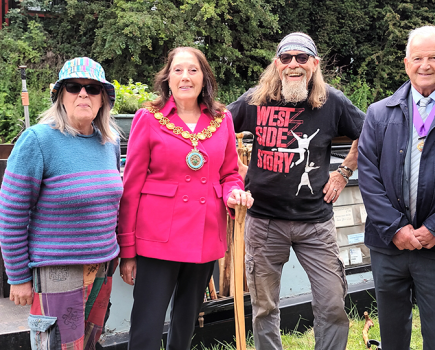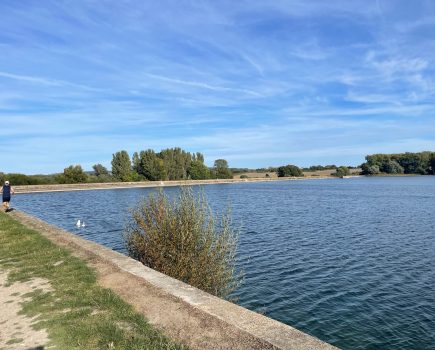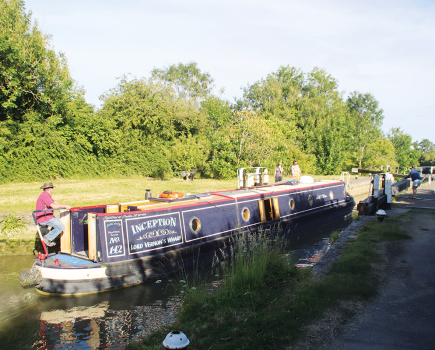Discover one of the most exciting UK inland waterways adventures with this guide to The Millennium Ribble Link, which connects the Leeds Liverpool Canal to the Lancaster Canal
The Millennium Ribble Link connects the Leeds Liverpool canal with the otherwise isolated Lancaster canal, and makes for a . The six-mile navigation was opened in 2002 at a cost of almost £6m. Navigating the link is quite simply the most exciting inland waterways adventure I have experienced….
My passage was ‘up onto the Lancaster canal’, and took place late in April 2021. Vessels up to 62ft can use the link between April and October by booking a slot with the Canal & River Trust.
Preparation
The link is tidal and therefore can only be undertaken on certain days that coincide with favourable tidal flows on the Rivers Douglas and Ribble. Passages are in one direction only (up or down) and the number of boats in each slot is limited. The CRT website has a simple bookings page that shows when places are available. Remember to book a return journey if you intend doing a there and back trip.
The CRT will email and text you to confirm the booking; 24 hours’ notice is needed to cancel a booking or a small fee will be charged. A useful CRT skipper’s information document is available to download.
Boats that travel on this waterway should be in good working order, there is no mooring and very few places to stop if things go awry. An anchor with 30m of warp is both necessary and reassuring. There are lots of different types of anchor that are suitable for different river beds; the substrate in The Ribble is predominantly sand/mud. The most important thing, however, is that it is heavy enough to hold your boat’s weight should you need to deploy it.
Lifejackets for everyone on board are essential as is a means of communication; a mobile phone is perfectly adequate. Some guides recommend coastal flares but we didn’t carry any during our trip. It is worth while checking that your insurance covers you for tidal links.
Sailings can only take place if the weather conditions are suitable, these include:
- A tide level of between 8.5 and 9.6m
- Winds of up to 4/5 on the Beaufort Scale
- Daylight hours and good visibility.
- A suitable flow of water into the Savick Brook.
If the CRT considers that the conditions aren’t suitable it has the right to cancel the operation. It will contact the boaters who have a passage booked and advise them of the next available slot. This might mean a wait of a few days in one of the holding areas at the northern and southern ends of the link.

Tarleton
Boats journeying north (up) are advised to be at the Tarleton visitor moorings 2.5 hours before their allotted time. These moorings are just passed The Town End swing bridge (no. 12.) at the top of the Rufford Branch of the Leeds Liverpool canal. It is a pleasant spot with a hard towpath, grassy banks and space for cars to park. Tarleton is a large village with some useful shops. There are no CRT services here though; if you need to fill up with water, the nearest is at Spark Bridge (no. 8a). Fuel can be difficult to obtain on the Lancaster so it’s a good idea to get some beforehand, especially if you plan an extended stay ‘up north’. Derek Bent from fuel boat Ambush can deliver supplies by road or boat.
Don’t be tempted to continue past the visitors’ moorings in your boat.
Although the canal continues for another half mile or so up to the tidal Tarleton lock 8 there is nowhere to turn around and it’s a busy place with barges on either side of the canal and awash with boat yard activity. It’s much better to moor up and then walk along the tow path to get a sense of what awaits you. There were two other boats travelling with me on the day I made the passage, it was lovely to stop and chat beforehand, there was a real sense of camaraderie and excitement. A few hours before your departure time a CRT employee will greet you, give you a briefing and a time to be at lock 8: it only takes 5-10mins to get there.

Tarleton Lock no. 8
The tidal lock is wide enough for two boats; there is no cill so boats can back up to the lock gates as the chamber is filled. It was amply manned with volunteers and a very enthusiastic CRT man whose main message was to “keep left out of the lock and to give it plenty of beans”. It was hard not to have a sense of glee and apprehension as we waited for the water to level off, I agreed with my fellow boater that he should go out of the lock first as he had a more powerful engine and had experience the link before. When the gates opened he was off like a shot and I was surprised at how strong the flow down the River Douglas was, it very quickly pushed his boat over to the right hand bank. I learned from this and pull out into the stream from a racing start keeping left as instructed.

River Douglas
The River Douglas was once the main navigation into Wigan back the days before the Leeds Liverpool canal was built, it now forms the first part of the Ribble Links northern bound passage. The river is narrow at first and the tide is strong and swift, my boat’s engine needed a steady 1,700 revs to make progress against it. After 20 mins the lead boat was in the distance and the third boat in our little party had overtaken my 40ft boat both having much larger engines than my three cylinder 28hp Lombardini. The site of the old Preston to Southport railway link can be seen just before Douglas Marina’s pontoon, the last place where you could stop in an emergency. The Douglas widens as you progress northwards, the tidal stream slows opening out into wide mudflats and a rich marshland environment: a haven for wading birds. I was surprised just how remote and special this landscape felt.

River Ribble
After about an hour we reached the confluence of The Douglas and Ribble. Your instinct is to cut across ‘the corner’ to take the shortest route. This would be a mistake as there is an unseen sand bank waiting to ground you. Instead, you must keep to the left hand bank of The Douglas and head to the left of the Asland Lamp on the Ribble (this reminded me of Narnia) and go behind it passing it to starboard (keep it on your right). We began to punch the outgoing tide as we made our way the 3.5 miles upstream towards the Savick Brook and the skyline of Preston. The navigation marks in the river countdown the miles and lead the way.
The other boats were just dots in the distance as Blackbird’s engine began to protest at all the work it was being made to do. Not too loudly at first, just the odd hiccup but as the tide began to make its seaward trek in earnest, we were forced to throttle back to 1,500 revs. There was clearly a problem with the fuel supply. I was confident that it wasn’t the filters as I had recently changed them, hmmm! I was barely making 1 knot against the current, the sheep in the adjacent fields were moving faster….

Savick Brook
The Savick Brook is a tidal creek that was widened during the construction of the link. At the junction with The Ribble there is a tidal rotating sealock (no.9) boats must reach this point in about 2.5/3 hours after leaving Tarleton otherwise there will not be sufficient water for them to progress. A green light, which can be seen some distance away, indicates that you can proceed. The junction is clearly marked on the left hand bank with a black and white CRT sign. I began to wonder what would happen if you reached the junction and there wasn’t enough water? It would impossible to turn around and go back. A phone call from the CRT’s helpful Stephen soon answered my question, as we had run out of time. Plan B was to head for Preston Docks, another mile upstream. I was instructed to aim for the right hand sea wall at the entrance and moor up.
My engine was spluttering rather alarming now as we (very) slowly edged forwards, it seemed as if the spire on of Preston’s many beautiful churches was on a piece of elastic so slow was our progress. I was glad that we had our anchor on-board and that it was ready on the bow in case it needed to be deployed. My ship mate and I had talked through who would do what in the event of the engine failing. The banks of the Ribble are steep and dry out completely as the tide goes out; there are lots of rocks and rubble, so in an emergency it would be better to anchor in the middle of the estuary so the boat could settle onto the flat mud and not be left at a jaunty angle on sharp rocks.

Preston Docks
Finally we reached the dock wall, where a very kind dock technician greeted us and helped to secure the boat’s lines to the moving tidal mooring rings. We couldn’t enter the marina as the sea locks were being repaired and there was no water in the outer basin. Our home for the night was not going to be where we had expected but that only added to the adventure. The first job was to have a look at the engine, especially the fuel system. We turned the fuel off and unscrewed the primary fuel filter, the problem was immediately obvious: diesel bug! The filter was clogged up with brown gunge causing an intermittent fuel supply which was making the engine splutter. My ship mate scaled the sea ladder and went into Preston marina to buy an additive which would kill the bacteria. We put this into the tank and changed both the primary and secondary filters with spares that it is always good to carry. As the tide went out we dropped lower and lower on the seawall until we settled gently into the mud. The sight around us was rather surreal: decades of mud sloping away in huge banks, an enormous stone wall and very impressive sea lock.
Even more surreal was waking in the night to find that we had risen over 6m and that we could almost see over the top of the wall. Six hours later we were back in the mud. We were advised to leave our resting place by 12.45 (high tide) to make the one mile passage back to the Savick Brook entrance. However at 10.45 the estuary was almost completely empty of water. At 11.00 on the dot a small bore could be seen coming towards us and the tide began to pour in as if a tap had been turned on. In two hours there was a tidal rise of 5m, an amazing sight to behold. We slipped our lines at slack water and had an uneventful motor back to the brook entrance making sure not to cut the corner.
We followed the red and green navigation marks to the sea lock and were greeted by a friendly CRT man who asked us to moor up on the pontoon to wait for the tide to fall enough so we could pass under two bridges. After an hour or so we were able to advance up the narrow, twisting brook, if I hadn’t have known better I would have thought that we had gone the wrong way! This brought us out into lock 8 and then a bit further on lock 7. Both locks were manned for us by the CRT. As it was now late in the afternoon we were asked to be ready at 9.00 the next morning to make the final assent up onto the Lancaster canal. The Savick brook widen out slightly as we worked our way up 3 more locks, again with the help of the CRT. The final flight is an impressive staircase system which longer boats have to reverse into. It’s overlooked by a remarkable silver sculpture.
As the final lock gate opens we found ourselves in a wide holding basin: the waiting area for boats doing ‘down’ the link. We went under the bridge and onto the Lancaster canal with a big smile on our faces. We turned right and travelled a mile or so towards Preston and the excellent Cadley services. What an adventure!
Image(s) provided by:
Archant







